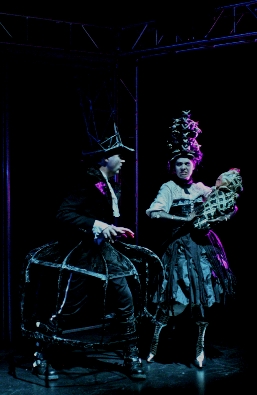With
Nevermore: The Imaginary Life and Mysterious Death of Edgar Allan Poe, members of
Catalyst Theatre display their considerable talent for physical theatre by interpreting the life-story of the famous American man-of-letters.
Considering how Poe himself was drawn to the macabre and the mysterious circumstances of his death, he is an ideal subject for their twisted Burtonesque fantasies. Nevermore follows Poe from cradle to grave, exposing a life of hardship: he is orphaned as a child, he is haunted by night terrors, he loses lovers and family to illness and is tortured by his losses; he is impoverished and driven to drink and despair. In Jonathan Christenson's version of events, the beleaguered Poe becomes the quintessential sad clown, a strange, vulnerable creature in wide pants and whiteface, a tragic man-boy who is the plaything of the cruel fates. The result is a spectacular fusion of fact and fantasy.
Part musical and part circus, realism is never the object in Nevermore. Instead, the characters that emerge from behind shadowy screens on the stage are grotesque comical figures. Costumes are essential to the play. Poe himself is a pale, raven-haired figure who, dwarfed by his own ruffled sleeves and an enormous leather-bound diary, seems like a doll. The personalities that surround him -- mother, sister, brother, step-parents, cousins, aunts, his publisher – are all dressed in wild attire. The women wear leather corsets, translucent gowns covered in ribbons that catch in the light, and huge umbrella-shaped or strange convex-cylindrical skirts.
The men are no less dandyish, in enormous stovepipe hats and spidery metalic jackets. All are dressed in black and white, so that their bodies seem to fade into the dark stage and yet hover above it, glowing like phosphorescent submarine creatures. Periodically, figures surface out of Poe's nightmarish imaginings: a faceless woman with clawed hands emerges from behind a row of mesh screens, accompanied by somber music. An actor floats across the stage in a huge horse-headed mask, twice the size of his body.
The cast of Nevermore offer a tightly rehearsed performance. For the better part of three hours, they sing – or perhaps intone is the better word – and dance, never slacking. Their enthusiasm is critical, because structurally Nevermore is repetitive, and without their unflagging energy, the play could easily get mired in its own linearity. Each episode from Poe's life winds towards an inevitably dismal end: his parents die, his brother abandons him, his step-father rejects him, his beloved betrays him, his child-bride dies. Part of the success of Nevermore comes from how it undercuts the typical romanticism of a musical with black humour and misadventure. The vignettes are ironically satisfying, and the audience can take strange pleasure in the tragi-comidy unfolding before them.
Ultimately, though, Nevermore is more spectacle than story. The world that Catalyst Theatre creates is breathtaking, and it reminds us that theatre is about the magic of illusion: light and shadow, disembodied voices that float from behind a curtain, skillfully contorted bodies, and gaudy costumes that transform a person into something more than human. Yet in the process the hisorical figure of Poe is erased. His stand-in is dancing mannikin with wild hair and a painted face, whose story is told in rhyming verse by two grinning carnival barkers. Nevermore is a beautiful but it is true only to itself, to technique and to fiction. The person who was Edgar Allan Poe remains elusive, hidden somewhere deeper and more mysterious than the velvet-curtained stage.
The Imaginary Life and Mysterious Death of Edgar Allan Poe; Writer, director, composer: Jonathan Christenson; Created by Catalyst Theatre; on until Feb 6 at the Arts Club - Granville Island Stage. For more information go here.




